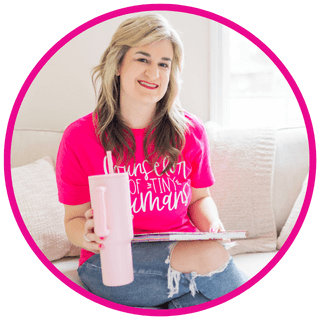
Hey y’all! Thanks so much for stopping by. My name is Laura and I am an Elementary School Counselor turned Curriculum Writer. At my precious school in Nashville, TN, 97% of my students were living in …
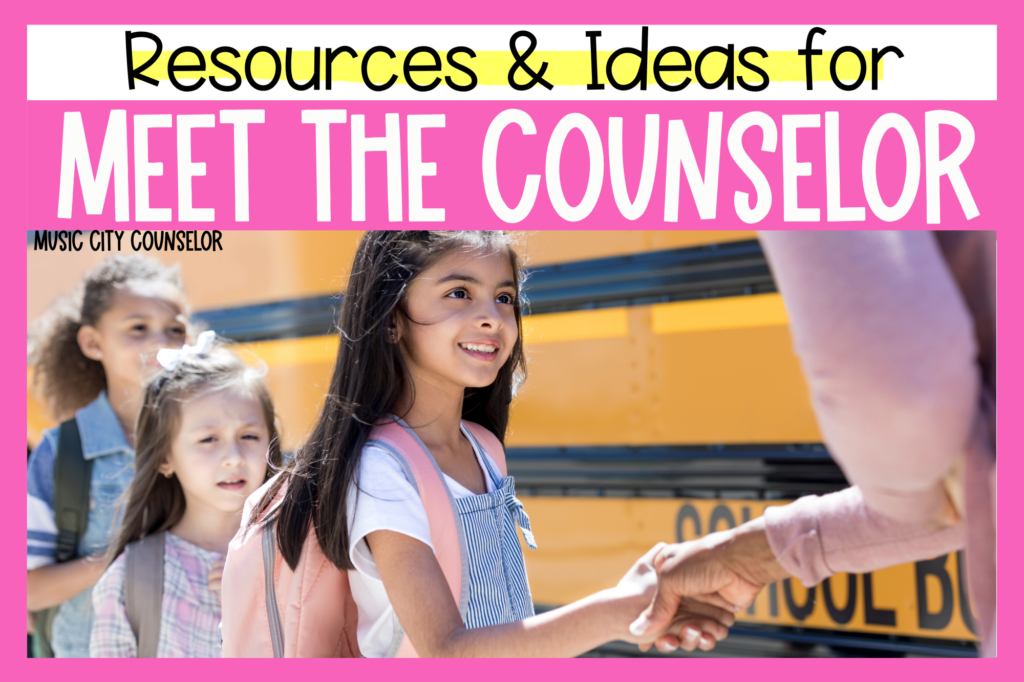
Has a student or teacher ever asked you, “So, what do you really do all day?” If they have, you are not alone! Students see first-hand the work their classroom teachers do each and every day, but the school counselor’s role can be a bit more mysterious. Many counselors are the only mental health professionals in their building and some of the services we offer take place behind-the-scenes.
But, when this sense of confusion about our role is widespread, it can lead to our stakeholders misusing or under-using us. In turn, we feel undervalued, misunderstood, and isolated. The role of the school counselor is central to the well being and climate of the entire school community, and it is our responsibility to advocate for and educate about our role. If we don’t do it, who else will?
My best advice is to start each school year with a presentation for your faculty, a lesson with your students, and a newsletter home to parents. Over my years of school counseling, I tried many different creative and fun ideas for my meet the school counselor lessons. Some were successful…and others weren’t. Through my trial and error, I came up with 5 qualities of an engaging and effective meet the counselor lesson that I will share first in this post. Then, I’ll take you on a little tour of the 7 meet the counselor lesson ideas I tried over the years and what went well (and didn’t go well!) with each one.

In most cases, the meet the school counselor lesson will be your first opportunity for face time with students at the beginning of a new school year. For first year school counselors and any new students attending your school, this will be your very first introduction! Take advantage of this opportunity to spark a memorable, meaningful, and positive connection with students. Go in with a big, warm smile. Show students that you are a kind, welcoming, and open-minded person who is there for them! Share a little bit about yourself (where you’re from, your family, your favorite things, etc.) so that students can get to know you on a personal level. Now is your time to shine and start building those meaningful connections with students so that when the need comes, they feel comfortable and ready to come to you!
If you know me, you know that I love creativity, innovation, and fun. And when it comes to lesson planning, my mantra is often, “the more creative, the better!” But, with the meet your counselor lesson, we need to be careful to not get too carried away with creativity…to the point where it muddles our focus. The central goal of this lesson is to introduce ourselves to students and teach them about the services we provide. To accomplish this, we need straight-forward, clear visuals and materials. Hooking students’ attention with something like the “Magic Coloring Book of Feelings” (Amazon affiliate link) is wonderful (more to come on that in a bit!) But, when it comes to teaching the nitty gritty about our role, the more metaphorical, “out-there” ideas often lead to confusion and misunderstanding. Our role is already confusing enough, so let’s get back to basics and present this information in an easy-to-understand way that ALL students can grasp.
I wanted my students to leave this lesson knowing that their school counselor was there to serve ALL students. I wanted them to know me as a warm and bubbly helper who could support them through just about anything. If I came to pick them up from class, it didn’t mean that something was “wrong” with them. We can all (young and old!) use support from a counselor from time to time. By normalizing and de-stigmatizing counseling, we can raise and educate children who are comfortable seeking and accessing help.
Confidentiality is a critical piece of building trust with students, so I made sure to explicitly explain it in my meet your counselor lesson. I wanted my students to know that whatever they share with me stays with me, unless someone was harming them, or they were hurting themselves or others. In that case, I would report what they shared to another grown-up who could help make sure they were safe. I took advantage of any opportunity to share what confidentiality meant with my students, and I recommend you do the same!
Once students knew what services I offered and how I could help, I made sure to explain my school-specific referral process. Whether it’s a little mailbox outside of your door, an official form received from teachers, or whichever method you choose, please make sure that students know how to access your services in a reliable (and confidential) way.
To save you time and trouble, I will share 7 of the meet the counselor lesson ideas I tried over the years, starting with my very first year as a school counselor! For each activity, I describe how it works, then share what went well (and didn’t go well) with the lesson.
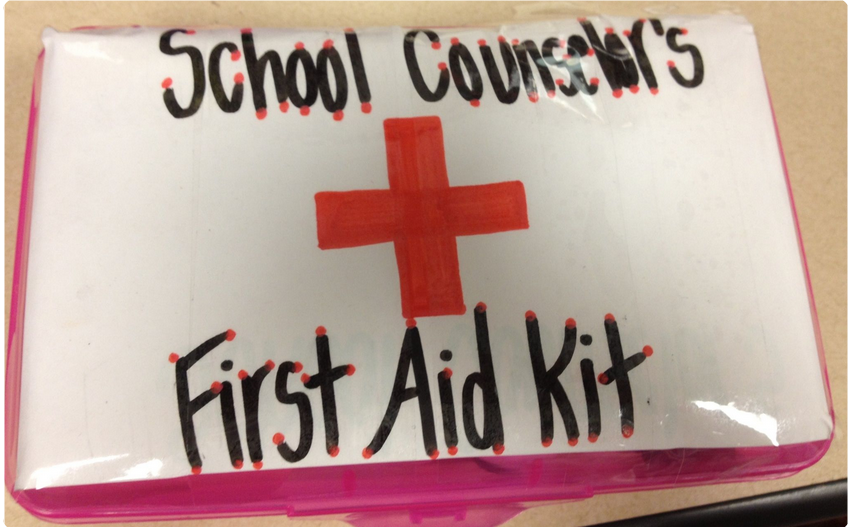
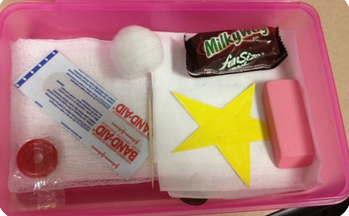
As a brand new, first year school counselor, I wanted to “wow” my new audience with a creative and innovative first lesson. I looked all over Pinterest and found what I thought was the perfect activity: the School Counselor’s First Aid Kit! I excitedly decorated a pencil box and gathered items that represented my role to place inside. A tissue to show that I can dry their tears, a band-aid to show that I can help them feel better when they are hurt, an eraser to show that I can help them learn from their mistakes, a penny to show that they are valuable and special, etc.
While this lesson had so much potential, I was so disappointed to see that, amidst the excitement and fun, my message was lost. Although my kit was as cute as can be, and a great source of hands-on, tactile, learning, it was just too abstract and metaphorical for my learners. When one student raised his hand and said, “Oh! So you’re like the school nurse! You can give me a band-aid!” I knew that although this was a great try, I needed to come up with something different for next year.

My next meet the counselor idea was one that I learned about on a counseling Facebook group, and sounded so clever and fun! I ordered a Potato Head™ doll and used it to introduce the role of the school counselor. For this activity, I placed all of the Potato Head™ parts in a brown paper lunch sack and invited students to take turns coming to the front and a part from the bag. After the student chose a part, he/she placed it on the doll and I explained how that piece helped us learn about a role of the school counselor. The ears were for listening, the mouth was for speaking kind words, the hands were for helping, etc.
Just like the first aid kit, this activity was hands-on, interactive, and fun…but most of the content flew right over my students’ heads. This lesson lacked the clear, straight-forward visuals and explanation that my students needed to understand who I was and how I could help them. My students remembered that I let them play with a Potato Head™ doll, but didn’t remember why. So, I decided to go a completely different route the following year.

For my third year as a school counselor, I decided to try my favorite way to open my classroom lessons: with a story! But, if you’ve done any research on this topic, you’ll find that there are very few books out there that teach about the role of the school counselor. “Mrs. Joyce Gives the Best High Fives” is the most popular one, and touches on just about all of the critical pieces of an effective meet the counselor lesson. It portrays Mrs. Joyce, the school counselor, as a warm, friendly, and likable character that helps students with all sorts of things (parents’ separation, test anxiety, making good choices, setting goals, problem solving skills, etc.). The story also explains confidentiality, the referral process, and that school counselors are partners with teachers and parents to help all students succeed.
I love how thorough this book is, as it highlights so many important roles and services of the school counselor. But I’m going to be brutally honest with you…phew, is it boring! I noticed my students drifting off a bit as I read and I can’t say that I blame them. After reading this to every single K – 4th grade classroom in my building, I was very, very tired of it! I vowed to find a more captivating and memorable story for the following year.

One of my favorite parts of being a school counselor was receiving adorable and heartfelt drawings and cards from my students. I’ll never forget receiving a note from a 4th grader saying, “Thank you for doing magic tricks with us!” I had done the “magic trick” with her class 5 years ago when she was in kindergarten…and she STILL remembered it!! That’s the “Magic Coloring Book of Feelings” (Amazon affiliate link) for ya! It captivates students like nothing else, and leaves them awestruck. Here’s how it works.
By flipping the pages of the book with your thumb at different positions on the outside edge, the pages change from black and white, to colored, to completely blank. Students cannot tell that you are moving your thumb, and think that the pages are changing magically! The possibilities for this book are endless, but my favorite way to use it was to explain how school counselors help children with their feelings. I compared our feelings to different colors (i.e. red = angry, blue = sad, yellow = happy, etc.), and first showed students the black and white images in the book. Then, I told them that we needed to add feelings to the book, and asked them to “gather their feelings” in their hands. At the count of 3, they “threw” their feelings at my book. Then, to my students’ amazement, I made the colorful pages appear! Finally, I asked students to “take” their feelings back,” and at the count of 3, they reached out towards the book and I showed the black and white pages.
All students, from PreK all the way to 4th grade, were completely enamored with this book. It is an amazing way to build a memorable, instant connection with students. This book alone is not sufficient for introducing the role of the school counselor, but it is a GREAT way to open the lesson! This trick plus an informational presentation on our role is a “magic” combination.
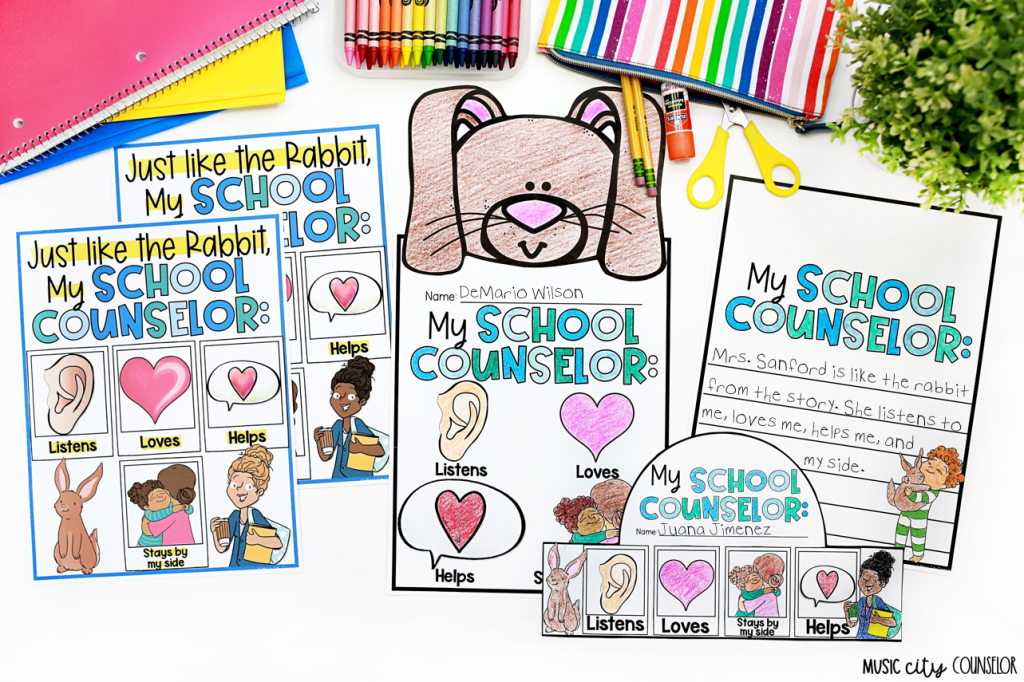
After realizing the hard way that “Mrs. Joyce” wasn’t the best fit for me and my population of students, I did a lot of searching to find the perfect book for my meet the counselor lesson. I came across “The Rabbit Listened” (Amazon affiliate link) thanks to Dolly Parton’s Imagination Library, and instantly knew that it was the perfect story for teaching about the role of the school counselor.
“The Rabbit Listened” tells the story of a child whose very special block tower he built falls down. He doesn’t know how to cope with his big feelings, and turns to several different animals for help. The chicken talks too much. The bear is too angry. And the snake is greedy and unkind. None of the animals offer Taylor what he needs…until the rabbit comes along. The rabbit simply stands close to Taylor and offers his listening ear. As Taylor shares his experiences and feelings with the rabbit, he starts to feel better and even gathers the strength to build a new (and even more amazing!) tower.
The rabbit is a beautiful and memorable representation of the school counselor. Just like the rabbit, school counselors listen, love, help, support, care, and stay by your side. Although the rabbit concept is metaphorical, it is so easy for all students to grasp. When one of my students called out, “You’re the rabbit! It’s you!” I knew that I had found a winner.
I created a companion lesson to this story that includes everything you need to teach about the role of the school counselor. It includes printable posters, a differentiated craft, and a digital presentation that teaches students all about the ways we can help: just like the rabbit.
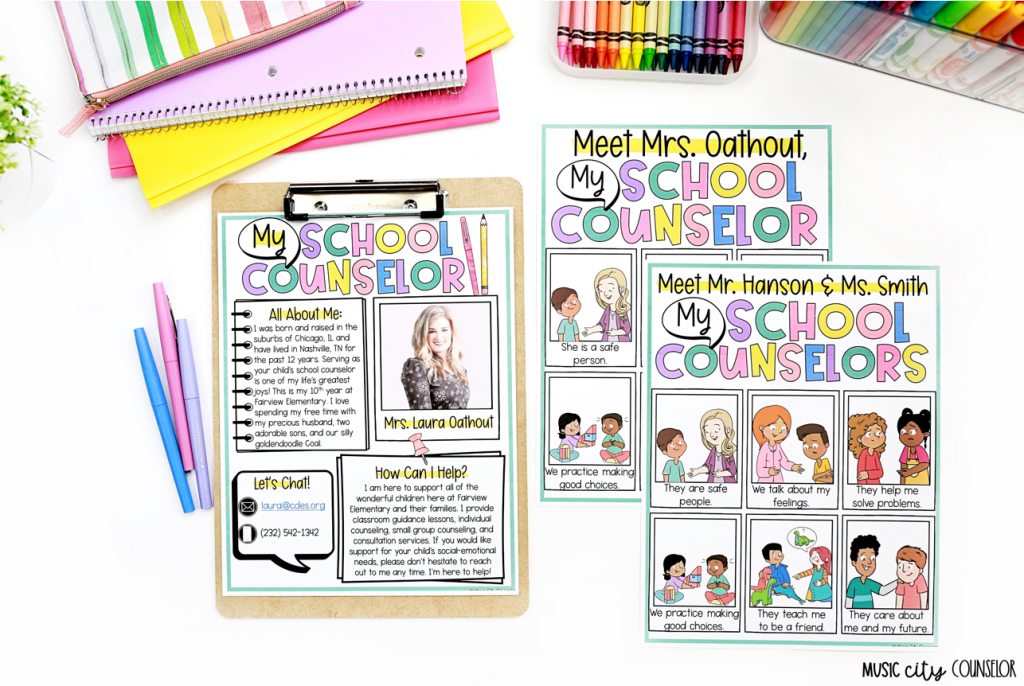
After my first few tries at my meet the counselor lesson flopped, I knew that I needed to create a straight-forward, to-the-point presentation to teach students all about me and the services that I offered. I created this PowerPoint and digital for Google Slides™ presentation that allows school counselors to add in photos and text to teach students about them, their family, favorite place, college, likes and dislikes, contact information, etc.! Then, students learn about confidentiality and the variety of ways that their school counselors can help.
I loved using this presentation after doing the “Magic Coloring Book of Feelings” magic trick or reading “The Rabbit Listened” story. An editable flyer, posters, coloring pages, and a bilingual coloring book all about the role of the school counselor are included, too!
And for upper elementary students, I loved to use this interactive meet the counselor sorting game! A digital drag-and-drop game for Google Slides™ and a printable bag sorting game are both included. The activity offers 34 scenarios, such as “My school counselor is a safe person I can talk to,” “My school counselor teaches me how to make and keep friends,” and “I go to my school counselor’s office when I’m in trouble.” Students read the statement and decide whether it is a job that the school counselor does or doesn’t do. This activity offers a thorough review of our role and will leave students with a very clear understanding of the services that we offer!
I hope that this post will help you plan engaging, effective, and memorable meet the counselor lessons for your students…and avoid some of the mistakes I made as a new counselor! What are your favorite meet the counselor resources? What has worked (and not worked) for you? I’d love to hear from you, please comment below!
You may be interested in:

| Cookie | Duration | Description |
|---|---|---|
| cookielawinfo-checkbox-analytics | 11 months | This cookie is set by GDPR Cookie Consent plugin. The cookie is used to store the user consent for the cookies in the category "Analytics". |
| cookielawinfo-checkbox-functional | 11 months | The cookie is set by GDPR cookie consent to record the user consent for the cookies in the category "Functional". |
| cookielawinfo-checkbox-necessary | 11 months | This cookie is set by GDPR Cookie Consent plugin. The cookies is used to store the user consent for the cookies in the category "Necessary". |
| cookielawinfo-checkbox-others | 11 months | This cookie is set by GDPR Cookie Consent plugin. The cookie is used to store the user consent for the cookies in the category "Other. |
| cookielawinfo-checkbox-performance | 11 months | This cookie is set by GDPR Cookie Consent plugin. The cookie is used to store the user consent for the cookies in the category "Performance". |
| viewed_cookie_policy | 11 months | The cookie is set by the GDPR Cookie Consent plugin and is used to store whether or not user has consented to the use of cookies. It does not store any personal data. |